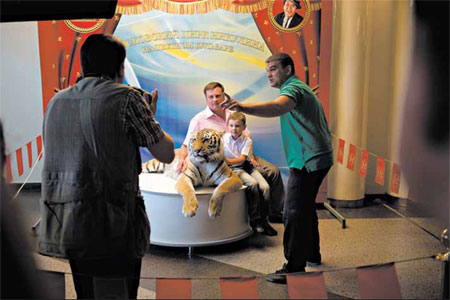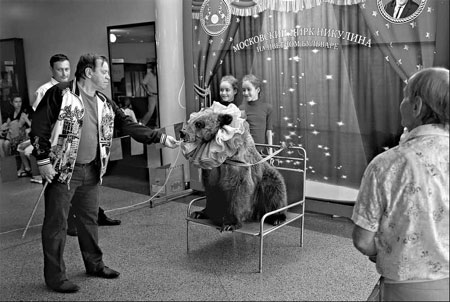A predator, subdued, ready to pose
Updated: 2013-07-21 08:24
By Andrew E. Kramer(The New York Times)
|
|||||||
|
James Hill for The New York Times |
|
James Hill for The New York Times |

Moscow
The father knelt beside his hesitant daughter and gently encouraged her to set aside her fears and take a seat. "Don't worry," he whispered, "it's just a little kitty."
But in fact, lounging on a low pedestal in the foyer of the Nikulin Circus in Moscow, and lazily twitching a long, tawny tail, the tigress named Chanel was no kitty at all.
She was a fully grown Siberian tiger, whose trainers use her as a toothy prop in one of the more alarming rituals of the Russian circus: the practice of photographing small children with predators during breaks in the show.
At intermission, she pads out on paws the size of saucers and takes a seat. While children crowd around, the huge and iridescent pools of her yellow eyes gaze back, inscrutable and wild, and wholly mysterious on the pressing question one concerned youngster had for her mother: "Do you think she is full?"
Placing children beside carnivorous beasts - even for a fleeting second as the trainer steps aside for a photograph - illustrates a deep-seated and widespread quality in Russian culture: This is a nation of inveterate risk takers. In business and politics, finance and aviation, a cavalier attitude to danger is deeply ingrained. In just one comparison, the World Health Organization said in 2010 that the mortality rate on the roads in Russia was 55.4 per 100,000 vehicles; it was 12 per 100,000 in Italy.
In the 19th century, the author Mikhail Lermontov was so amazed by this quality of fatalism he created a character in the novel "A Hero of Our Time" who played Russian roulette with a single-shot pistol. That character is saved by a misfire.
When asked about the danger at the circus, Andrei Y. Logulov, a thin, clean-cut chemical engineer who was encouraging his daughter, 11-year-old Diana, to approach Chanel for a picture, shrugged like so many other Russians.
All this makes Russia the land of the preventable accident, the tragic outcome and the bet gone bad, in the circus as elsewhere.
And "accidents" there have been. Last year a tiger with a traveling circus bit the head of a 2-year-old boy during a photo session in the Far East city of Blagoveshchensk; the boy survived, though the bite reportedly fractured his skull.
"Of course this is risky," Mr. Logulov said, "but risk is everywhere in life. A brick could fall on your head in the street, for example. And this is just a small risk."
In recent years, a snow leopard scratched a school girl at a traveling tent circus outside Moscow, and a
tiger bit a spectator in the Black Sea resort of Sochi. Of the roughly 90 species of animals used in circuses, a dozen or so are deemed by circus administrators as particularly dangerous: monkeys, tigers, lions, lynxes, pumas, bears, sea lions, walruses, eagles, kangaroos, hippopotamuses, rhinoceroses and elephants.
Yet, for the extra thrill and income, the roughly 100 circuses that were privatized after the Soviet collapse routinely allow a relatively tame member of one of these species to stroll out into the entrance hall during breaks for photographs. At the Nikulin Circus a picture with a tiger costs $18, and one with a bear is $15. The approximately 70 circuses that are still run by the state have prohibited such practices since 2010.
Boris E. Maikhrovsky, a deputy director in charge of animal acts at Rosgostsirk, the state circus company, and a trainer of sea lions and penguins, said putting children be side predators was inherently unsafe. It is, he said, not so much illustrative of Russian fatalism as a sign of the profit motive overwhelming common sense. Mr. Maikhrovsky is advocating in the Russian Senate for a law that would prohibit taking children's pictures with predatory animals.
"We have an order categorically forbidding photographing with animals," Mr. Maikhrovsky said. "Whoever does this knows it will end badly one day. We can never know what is in the head of an animal." Trainers sometimes drug big cats before such photo sessions, he said, though that does not always help.
Maksim Y. Nikulin, the director of the Nikulin Circus and the scion of a prominent family of circus performers, defended the sessions as safe and a fine example of showmanship. Besides, he said, the appearance of danger is integral to the circus arts.
"People go to the circus for adrenaline," he said. "If it appeared to be entirely safe it would not be interesting. You watch and you think, oh, that man could be eaten right now,' or that gymnast could fall right now.'"
Chanel, Mr. Nikulin said, is an inherently calm tiger desensitized from an early age to the squeals of children and even the occasional ill-advised pinch. He denied she is drugged.
Out on her stage during a recent intermission, Chanel gazed blankly at the crowd of children.
Mikhail Zaretsky, her trainer, explained the safety precautions he takes, like feeding the animal a hearty four kilograms of raw beef before a photo session.
As Diana took a seat, she stretched her spindly arm over Chanel's neck, petting her gently.
In the crowd, some parents talked their skittish children into being photographed, while others tried to talk their children out of it.
One woman who has been working at a nearby ice cream stand for years rolled her eyes and said, "Praise God, nothing bad has happened here."
Meanwhile, Anya, a 6-year-old with a white bow in her hair, stood at the edge of Chanel's enclosure. She looked at the tiger, then looked up at her mother and said, "I'm afraid." The mother, Yulia M. Baranova, decided not to take the picture.
"We looked at her teeth, we looked at her claws," she said, and moved on to the stands offering cotton candy, vampire teeth and yo-yos.
The New York Times
(China Daily 07/21/2013 page9)

